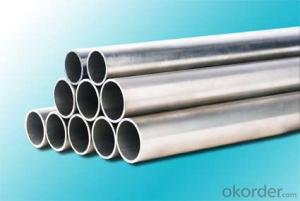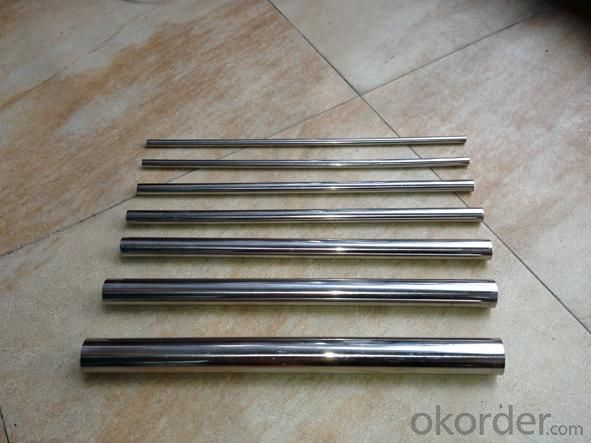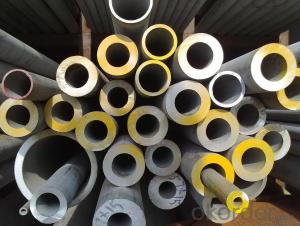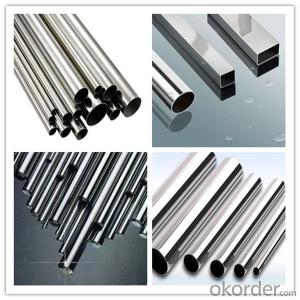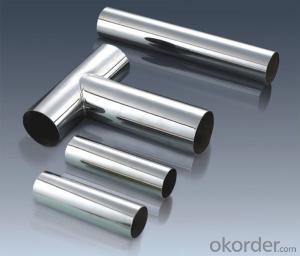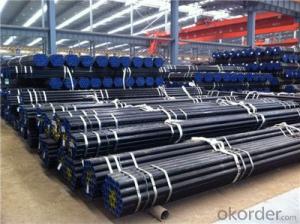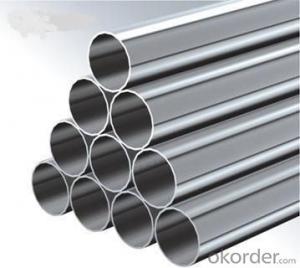Steel Manufacturing Company 304 Stainless Steel Pipe Price Per Meter
- Loading Port:
- Tianjin
- Payment Terms:
- TT OR LC
- Min Order Qty:
- 25 m.t.
- Supply Capability:
- 1000 m.t./month
OKorder Service Pledge
OKorder Financial Service
You Might Also Like
Quick Details
| Standard: | JIS,AISI,ASTM,GB,DIN,EN | Place of Origin: | China (Mainland) | Brand Name: | OKORDER |
| Model Number: | 200, 300 series | Type: | Seamless | Steel Grade: | 300 Series |
| Application: | Industry and decoration,Construction and decoration | Certification: | SGS | Welding Line Type: | Spiral Welded |
| Thickness: | 0.4-30mm, or customized | Outer Diameter: | 6-630mm, or customized | Material: | 201,202,304,304L,304N,304LN,309S,310S,316,316L |
| LENGTH: | 2000-6000mm, or customiazed | Surface: | Pickled,80grit,160grit,600grit,polished finish, bright finish | MOQ: | 500 kg |
| Payment terms: | T/T,L/C at sight | Advantage: | stable spec & accurate dimension | TECHNOLOGY: | seamless |
| INNER DIAMETER: | 5-600mm, or customized |
Packaging & Delivery
| Packaging Detail: | Products are well packed and clear labeled according to the regulations and customer's requests. |
| Delivery Detail: | 3-15days after receiving deposit |
Specifications
Stainless steel pipe
1.Material:301,304,316,430,etc
2.surface: 2B, No.1, BA,8K etc
3.Diameter:6~630mm
Steel Manufacturing Company 304 Stainless Steel Pipe Price Per Meter
- Q: What is the difference between 304LN and 304 stainless steel pipes?
- The main difference between 304LN and 304 stainless steel pipes lies in the nitrogen content. 304LN stainless steel contains a higher nitrogen content, which improves its strength and corrosion resistance compared to 304 stainless steel. This makes 304LN a better choice for applications where high strength and resistance to corrosion are important factors.
- Q: How do you protect stainless steel pipes from internal corrosion?
- To safeguard stainless steel pipes from internal corrosion, one effective approach is the utilization of a corrosion inhibitor. These inhibitors, which are chemical substances, can be incorporated into the fluid that flows through the pipes. This addition creates a protective layer on the inner surface of the pipe, acting as a barrier that prevents direct contact between the corrosive agents in the fluid and the stainless steel. Multiple types of corrosion inhibitors exist, and the choice depends on the specific application and the nature of the fluid being transported. Examples include organic inhibitors, which generate a protective film on the pipe's surface, and inorganic inhibitors, which interact with the corrosive agents to form less harmful compounds. An alternative method for shielding stainless steel pipes from internal corrosion involves cathodic protection. This technique entails linking the stainless steel pipe to a sacrificial anode composed of a more reactive metal like zinc or aluminum. This connection establishes a galvanic cell, whereby the anode corrodes instead of the stainless steel pipe. By sacrificing the anode, the pipe is effectively shielded from internal corrosion. Regular maintenance and inspection are also vital in preventing internal corrosion. It is crucial to monitor the condition of the pipes, promptly identify any indications of corrosion or damage, and promptly address any issues. Flushing the pipes with clean water or suitable cleaning solutions can aid in the removal of any deposits or contaminants that might contribute to corrosion. Moreover, maintaining the proper composition and pH levels of the fluid is essential in preventing internal corrosion. In certain cases, adjusting the fluid's pH or adding corrosion inhibitors tailored to the specific fluid being transported can significantly decrease the risk of corrosion. In conclusion, the combination of corrosion inhibitors, cathodic protection, regular maintenance, and appropriate fluid management is an effective means of safeguarding stainless steel pipes from internal corrosion. This approach ensures the pipes' durability and optimal performance.
- Q: Can stainless steel pipes be insulated with polyetherimide?
- Yes, stainless steel pipes can be insulated with polyetherimide. Polyetherimide (PEI) is a high-performance thermoplastic that has excellent thermal stability and insulating properties. It can be used as an insulation material for various applications, including pipe insulation. PEI offers good resistance to heat, chemicals, and electrical conductivity, making it suitable for insulating stainless steel pipes in different industries such as oil and gas, chemical processing, and aerospace. Additionally, PEI has a high glass transition temperature, which allows it to withstand high temperatures without melting or deforming, further enhancing its suitability for insulating stainless steel pipes.
- Q: What is the maximum pressure that stainless steel pipes can handle?
- The maximum pressure that stainless steel pipes can handle depends on various factors such as the grade of stainless steel, the pipe's dimensions, the temperature of the fluid being transported, and the specific application of the pipe. Stainless steel pipes are known for their high strength and corrosion resistance, making them suitable for a wide range of applications where pressure is a concern. The most commonly used stainless steel grades for pipes are 304 and 316, which have different mechanical properties and maximum pressure ratings. For instance, type 304 stainless steel pipes have a maximum pressure rating of around 14,000 psi (pounds per square inch) at room temperature. However, this rating can vary depending on the pipe's wall thickness and diameter. Thicker pipes with larger diameters can generally handle higher pressures. On the other hand, type 316 stainless steel pipes are known for their increased corrosion resistance, especially in environments with chloride ions. They have a slightly higher maximum pressure rating compared to type 304, usually around 15,000 psi at room temperature. It is essential to note that the maximum pressure rating decreases as the temperature of the fluid increases. Stainless steel's mechanical properties change with temperature, and its strength reduces as it gets hotter. Therefore, it is crucial to consider the maximum operating temperature and determine the appropriate pressure rating accordingly. Additionally, it is always recommended to consult relevant industry standards, codes, and regulations, such as ASME B31.3 for process piping or ASME B31.1 for power piping, as they provide detailed guidelines on the maximum pressure ratings for stainless steel pipes in various applications. To ensure the safety and reliability of stainless steel pipes under high-pressure conditions, it is advisable to consult with a qualified engineer or a specialist in stainless steel piping systems. They can evaluate the specific requirements of your application and provide accurate information regarding the maximum pressure that stainless steel pipes can handle.
- Q: Can stainless steel pipes be used for ornamental purposes?
- Yes, stainless steel pipes can indeed be used for ornamental purposes. Stainless steel is known for its aesthetic appeal, durability, and resistance to corrosion, making it an ideal choice for decorative applications such as railings, handrails, furniture, sculptures, and architectural elements. Additionally, stainless steel pipes can be polished, brushed, or coated in different finishes to enhance their visual appeal and suit various design preferences.
- Q: Are stainless steel pipes suitable for marine applications?
- Yes, stainless steel pipes are highly suitable for marine applications. Stainless steel is known for its excellent corrosion resistance, which makes it ideal for use in marine environments where it is exposed to saltwater and other harsh conditions. The high levels of chromium in stainless steel create a protective oxide layer on the surface, preventing corrosion and rusting. This oxide layer also helps in maintaining the integrity and strength of the pipes over time. Additionally, stainless steel pipes offer good mechanical properties and are resistant to high temperatures, making them well-suited for various marine applications such as offshore platforms, shipbuilding, and underwater pipelines. Due to their durability, longevity, and resistance to corrosion, stainless steel pipes are a reliable choice for marine applications.
- Q: Can stainless steel pipes be wrapped with tape?
- Stainless steel pipes can indeed be wrapped with tape. However, it is crucial to use the appropriate tape specifically designed for stainless steel. The reason for this is that stainless steel pipes are commonly utilized in industrial and high-temperature settings, and regular tapes may not endure the extreme conditions. Typically, stainless steel pipe tapes are constructed from materials like stainless steel foil or aluminum foil, along with a heat-resistant adhesive, guaranteeing long-lasting durability and resistance to corrosion. These tapes serve a variety of purposes, including insulation, sealing, and protection against abrasion. It is always advisable to consult the manufacturer's guidelines or seek professional advice prior to applying any tape to stainless steel pipes, ensuring correct installation and avoiding any potential issues.
- Q: Are stainless steel pipes magnetic?
- No, stainless steel pipes are generally not magnetic.
- Q: How do you calculate the wall thickness of a stainless steel pipe?
- The wall thickness of a stainless steel pipe can be calculated by subtracting the inner diameter from the outer diameter, and then dividing the result by 2.
- Q: Are stainless steel pipes suitable for high-temperature applications?
- Indeed, high-temperature applications are well-suited for stainless steel pipes. Renowned for its remarkable resistance to corrosion, impressive strength, and ability to withstand heat, stainless steel is highly regarded. Its structural integrity and performance remain intact even under extreme temperatures. Stainless steel pipes find utility in numerous industries like power generation, petrochemical, oil and gas, and food processing, where elevated temperatures are prevalent. Moreover, the durability and extensive lifespan of stainless steel pipes make them a dependable option for high-temperature applications.
Send your message to us
Steel Manufacturing Company 304 Stainless Steel Pipe Price Per Meter
- Loading Port:
- Tianjin
- Payment Terms:
- TT OR LC
- Min Order Qty:
- 25 m.t.
- Supply Capability:
- 1000 m.t./month
OKorder Service Pledge
OKorder Financial Service
Similar products
Hot products
Hot Searches
Related keywords

